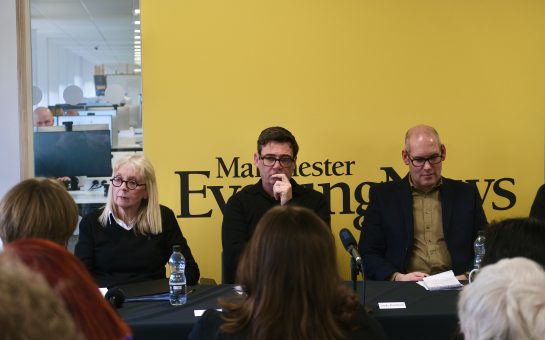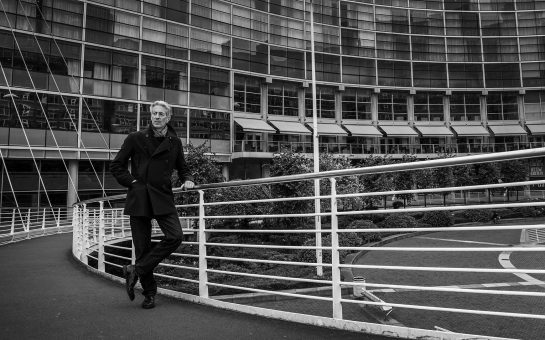Tragedy hit the streets of Piccadilly 34 years ago this week when a deadly blaze swept through a six floor Woolworths store, killing 10.
At around 13:30 on Tuesday 8 May 1979, Greater Manchester Fire Brigade control received a 999 call reporting smoke billowing from the store opposite Piccadilly Gardens.
Fire crews arrived at the scene to find smoke spilling out the building and people calling for help from the windows – it was thought that 500 customers and staff were inside.
For many it is etched in their memory – DJ Kelly, a researcher and author of historical fiction, originally from Chetham but now living in Buckinghamshire, remembers it vividly.
She said: “I was actually in the store when the fire broke out. I was browsing on the ground floor of the store when I heard quite a commotion and people suddenly came galloping down the escalator and ran out of the store.”
Unaware of what was happening inside, she assumed that it was a group of over-excited rampaging football fans.
She recalls that the fleeing shoppers knocked over a woman encumbered by shopping bags in their rush to leave, knocking her to the floor.
Unaware of the reason for the mass exodus, Ms Kelly left the store and continued shopping in Lewis’ department store situated across the street.
At the time Ms Kelly had a career in government service and was due to move to Pakistan the week after the fire.
She was in the city centre to stock up on her favourite shampoo and half an hour after leaving the Woolworths store she emerged from Lewis’ to see the commotion outside.
“Great clouds of dense black smoke billowed out of an upstairs window of the store, enveloping a terrified man who was perched on the window ledge,” she said.
Hundreds of horror-struck onlookers gathered silently behind a police cordon.
She said: “Everyone watching was praying and many were in tears. I’ll also never forget the shocked face of the very young constable who was standing near me, trying to keep the crowds back.”
Since the incident, Ms Kelly has had many sleepless nights and can still picture the trapped man struggling to breathe and keep his balance on the narrow window ledge.
“It was awful watching someone helplessly and thinking he might die,” she said.
The tragic events of that day will always remain in her mind and continue to affect her daily life.
She said: “I am still somewhat obsessive to this day about noting the location of fire evacuation points whenever I enter a large building.
“On a positive note though, it left me with a healthy regard for fire evacuation procedures.”
Fire-fighters tackled the inferno for two-and-a-half hours, helping to rescue people out of the building via doors, windows and the roof.
A fireman who attended the scene shared his memories of the dramatic rescue on Manchester-Forum under the name of Badharp.
He said: “I was one of the fire men from London Road who attended that day and was on the 35 foot ladder around the back trying to get the staff out of the windows.”
His team rescued four people from the windows, although they all needed air due to smoke inhalation.
At 15:51 fire officers declared that the fire was extinguished and a search of the building was carried out.
Upon searching the building, it was found that 10 people had lost their lives, 47 were taken to hospital for treatment and six fire officers had been injured.
Fire-fighters who attended were praised by many for their bravery and it is thought that if it had not been for their quick actions many more would have perished.
The fire was, at the time, Manchester’s worst fire since World War II and fire services identified three reasons why it was so deadly.
It is thought that the fire started after a damaged electrical cable ignited furniture filled with polyurethane foam.
In 1979 the full dangers of polyurethane foam was not known, but we now know that if ignited the foam produces toxic fumes.
The burning furniture released large amounts of thick toxic smoke that not only caused breathing problems but also obscured the fire exits.
Many of those that died were in the restaurant on the second floor – the same floor as the furniture display – as they were overcome by smoke.
Another witness of the fire called Kate said: “I remember reading in the newspaper at the time that one man had to be dragged from the restaurant because he wanted to finish his meal despite the flames across the floor.”
Another reason why the fire was so devastating is that the store had no sprinkler system fitted – it was not until fire crews arrived that any effort could be made to tackle the blaze.
The final reason was that the upper windows of the store had thick iron bars covering them which remained from when the building had been a bonded warehouse.
Despite attempts by fire crews to pry the bars off the windows with axes and crowbars they were unsuccessful and had to wait for specialist machinery to arrive.
An air-operated saw had to be used and firemen managed to cut two of the bars then bend them outwards to rescue six people.
Kate counts herself lucky that she was not in store that day – she had planned to visit the shop but was warned away by a ghostly premonition.
She was going to go to the store to purchase two Lego Thatcher Perkins trains – one for herself and one for a friend in Wales – as they were heavily reduced.
“On the Monday my overlocking machine broke down and as it was sunny I decided to some washing,” she said.
“In the midst of sorting the laundry out I heard my Grandmother’s voice, who died in 1956, saying ‘Go to town today’ I said out loud ‘No it might rain tomorrow’ and I heard her again louder insisting I go that day.”
As a result she took her daughter to Woolworths that day instead, even visiting the same floor where the fire started the next day.
She found out about the fire when her friend telephoned her to check up on her as he knew she had been planning on visiting the store that day to buy his train set.
News of the disaster travelled fast and one forum user who lived in Los Angeles at the time found out about the blaze on American television news.
Another witness to the fire, Margaret, said: “One of my neighbours on the ground floor shouted up to me that as I was from Manchester, England, I might be interested in an item that was the news.
“I turned on my TV to see Woolworth’s and remember just sitting down with shock.”
She recalls immediately phoning home to check if any family members had been involved and thankfully no-one she knew had been involved.
Having already made the decision to return home to the UK, the terrible events of that day confirmed to her she had made the right decision.
After an investigation into the fire, Fire Officer Bob Graham decided something must be done to prevent another tragedy like this happening again.
He campaigned along with others to persuade the government to change fire laws so that furniture makers would have to use flame-resistant foam.
He fought for over ten years and his campaign eventually received the support of Tony Blair and in 1988 The Furniture and Furnishing Fire Safety Regulations came into effect.
The fire became the centre of controversy last year when footage of the blaze was used in artwork that won the Turner Prize.
Elizabeth Price collated music, photographs, video footage and text depicting the fire in her work entitled ‘The Woolworths Choir of 1979’.
Families of those who died in the blaze were enraged, despite Price claiming it was ‘a way to remember’ the event.
It was announced in January 2013 that the site of the disaster would be transformed into a £20million hotel, restaurant and shopping complex.
It will house a 157 room Travelodge, a Morrisons convenience store and Zizzi and Nando’s restaurants – it is due to be completed in December 2013.
For many in Manchester it will always remain a place of historical significance and tragedy that should never be forgotten.
Image courtesy of Jonathan Robinson via YouTube, with thanks.
For more on this story and many others, follow Mancunian Matters on Twitter and Facebook.



